
Grimaldi, François
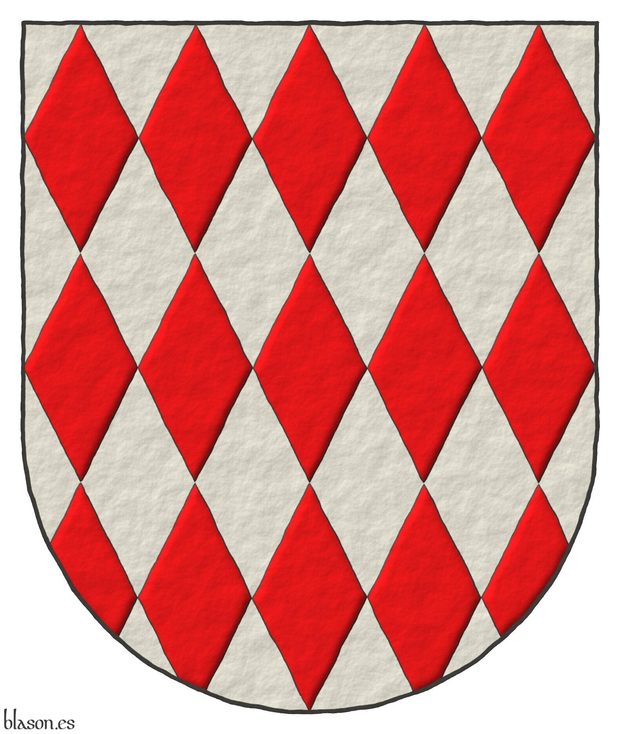
François Grimaldi ~ Francisco Grimaldi ~ Francesco Grimaldi.
Fusilly Argent and Gules.
Escudo fusado de plata y gules.
Coat of arms interpreted with: the semicircular base shape; the field of plain metal Argent; the fusils illuminated in Gules, outlined in Sable; the fusilly of proportion 3 x 5; and the whole with a raised-stroke effect.
Unlike how I have blazoned it here, this coat of arms can be found blazoned in [Arco y García, F. del; 1996b; page 10] as «Fusilly Argent and Gules».
He was the Genoese leader of the Guelphs who conquered the so-called Rock of Monaco on January 8, 1297, at night. To enter his fortress and have the gates opened for him, he dressed as a Franciscan monk along with his cousin Rainier I, Lord of Cagnes, and thus entered with his group of armed men. That is why the coat of arms of the Principality of Monaco has as supporters 2 Franciscan monks unsheathing their swords.
Francesco Grimaldi had no children, so after his death in 1309, he was succeeded by his cousin Rainier I, with whom he entered Monaco, and it is from Rainier I that the Grimaldi family and the Princes of Monaco who have governed the Principality ever since descend.
Blazon keywords: Fusado, Argent and Gules.
Style keywords: Semi-circular, Illuminated, Outlined in sable and Freehand.
Classification: Interpreted and Personal.
Bearer: Grimaldi, François.


Daubeny, Rauf

Ralph de Albini (XIII century) ~ Rauf de Albini.
Gules, a fess of five fusils Argent.
Escudo de gules, una faja de cinco fusos de plata.
Coat of arms interpreted with: the semicircular base shape; the field illuminated in Gules; the fusils illuminated in metal Argent, outlined in Sable; the fess of 5 fusils; and the whole with a raised-stroke effect.
Can be found blazoned in [Roll of Arms, B; 1254-1264; shield number 108], where it says: «Gules: 5 fusils en fess d'argent.».
Blazon keywords: Gules, Fusil, Argent and In fess.
Style keywords: Semi-circular, Illuminated, Outlined in sable and Freehand.
Classification: Interpreted and Personal.
Bearer: Daubeny, Rauf.


Rauf Daubeny
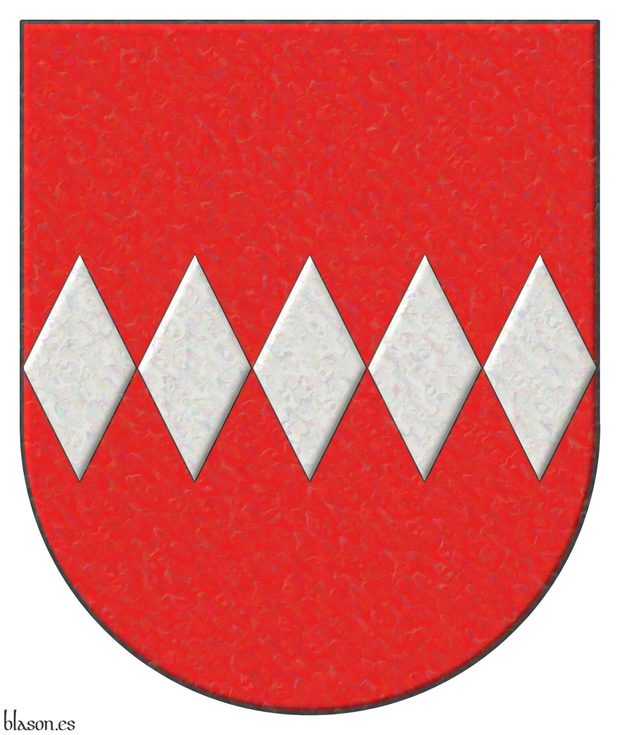
Ralph de Albini ~ Rauf de Albini.
Gules, a fess of five fusils Argent.
Escudo de gules, una faja de cinco fusos de plata.
Coat of arms interpreted in the following manner: the shape of the base is semicircular; the field is illuminated in Gules; the fusils outlined in Sable and illuminated in metal Argent; the fess is 5 fusils in length; and the whole with an iridescent finish.
I tend to blazon «Gules, a fess of five fusils Argent» ~ «Escudo de gules, una faja de cinco fusos de plata» which, as the piece called a fess touches the edges of the shield and is a unit, means the fusils touch the edges of the shield and touch each other, forming a single fess of 5.
While in the blazon «Gules, five fusils in fess Argent.» ~ «Escudo de gules, cinco fusos en faja de plata» the fusils neither touch each other nor the edges of the shield; this second blazon tells us that the fusils are «in fess» ~ «en faja», it does not tell us that they are forming a fess.
Blazon keywords: Gules, Fusil, Argent and In fess.
Style keywords: Semi-circular, Illuminated, Outlined in sable and Iridescent.
Classification: Interpreted and Personal.
Bearer: Daubeny, Rauf.


Daubeny, Philip

Philip Daubeney ~ Philip Daubeny.
Gules, a fess of five fusils Argent, in chief three mullets Or.
Escudo de gules, una faja de cinco fusos de plata, en jefe tres estrellas de oro.
Coat of arms interpreted with: the semicircular base shape; the field illuminated in Gules; the fusils illuminated in metal Argent, outlined in Sable; the fess of 5 fusils; the 3 mullets in chief of 5 points, illuminated in Or and outlined in Sable; and the whole with a raised-stroke effect.
The English term «mullet» used in this blazon refers to a 5-pointed, non-wavy star.
Blazon keywords: Gules, Fusil, Argent, In fess, Mullet, Or and In chief.
Style keywords: Semi-circular, Illuminated, Outlined in sable and Freehand.
Classification: Interpreted and Personal.
Bearer: Daubeny, Philip.


Philip Daubeny
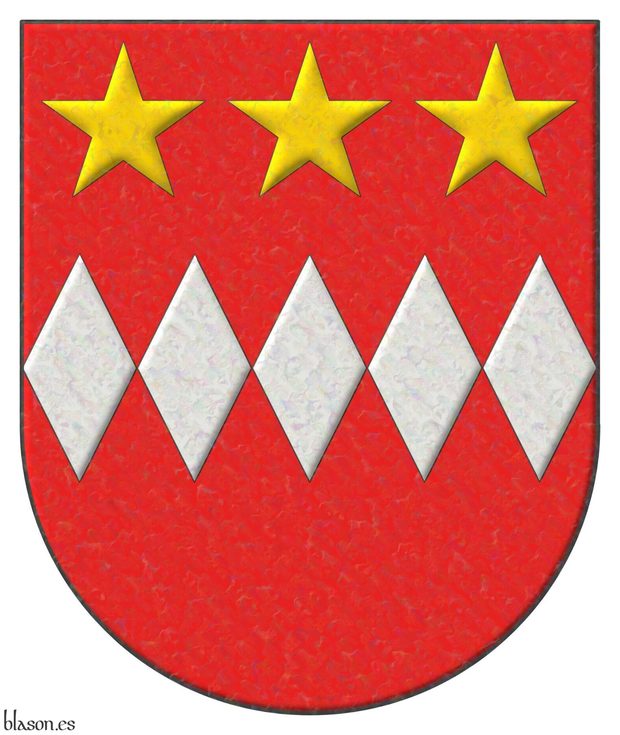
Philip Daubeny ~ Philip Daubeney.
Gules, a fess of five fusils Argent, in chief three mullets Or.
Escudo de gules, una faja de cinco fusos de plata, en jefe tres estrellas de oro.
Coat of arms interpreted in the following manner: the shape of the base is semicircular; the field is illuminated in Gules; the fusils outlined in Sable and illuminated in metal Argent; the fess is 5 fusils in length; the 3 mullets in chief of 5 points, outlined in Sable and illuminated in metal Or; and the whole with an iridescent finish.
This post corresponds to the English post number 61 in the same series.
Blazon keywords: Gules, Fusil, Argent, In fess, Mullet, Or and In chief.
Style keywords: Semi-circular, Illuminated, Outlined in sable and Iridescent.
Classification: Interpreted and Personal.
Bearer: Daubeny, Philip.


Berry of Molland
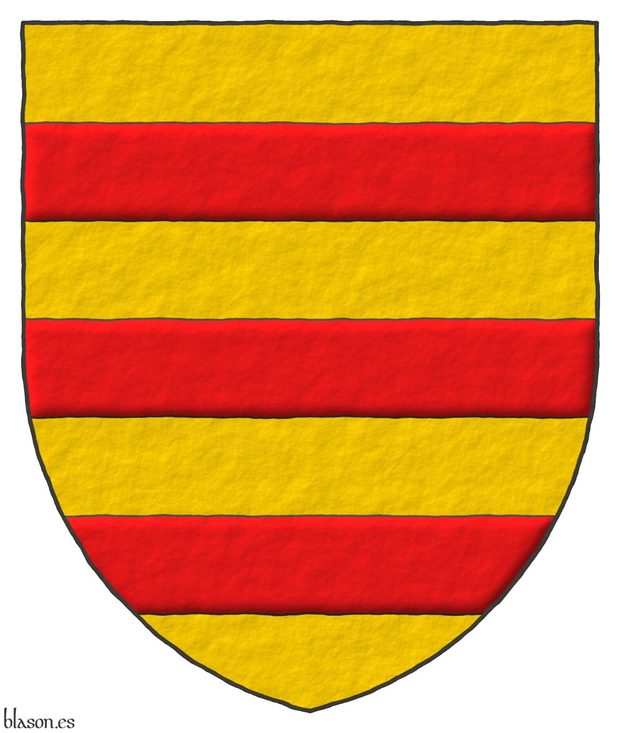
Berry of Molland, Devonshire.
Or, three fesses Gules.
Escudo de oro, tres fajas de gules.
It is possible that an English-speaking herald would have blazoned it as «Or, three bars Gules.» using the term «bars» instead of «fesses», just as in Castilian one sometimes uses the term «barras» instead of «palos», perhaps because these terms were not completely settled from the outset.
Blazon keywords: Without divisions, Or, Fess and Gules.
Style keywords: Pointed, Illuminated, Outlined in sable and Freehand.
Classification: Interpreted and Personal.
Bearer: Berry of Molland.
Blazon equivalent to: Clement V.


Berry, John
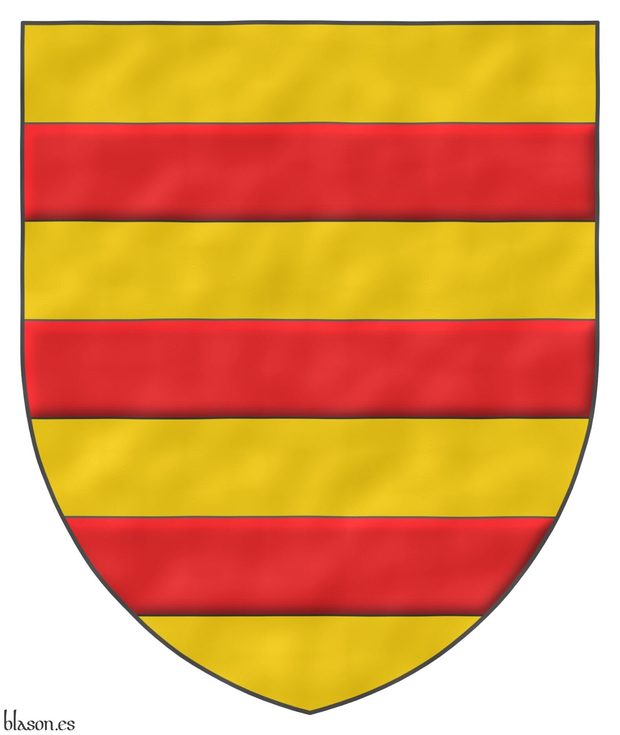
Admiral Sir John Berry (1635-1690)
Or, three fesses Gules.
Escudo de oro, tres fajas de gules.
Coat of arms interpreted as follows: the shape of the shield is pointed; the field is plain metal Or; the fesses outlined in Sable and illuminated in Gules; and the finish is watercoloured.
Sir John Berry bears the arms of the Berry of Molland family of Devonshire. He was born in Knowstone, North Devon, the second son of Reverend Daniel Berry, and served in the British Navy.
Blazon keywords: Without divisions, Or, Fess and Gules.
Style keywords: Pointed, Illuminated, Outlined in sable and Watercolor.
Classification: Interpreted, Personal and Army and Navy.
Bearer: Berry, John.
Blazon equivalent to: Clement V.


John Berry

Sir John Berry, Admiral of the Royal Navy
Or, three fesses Gules.
Escudo de oro, tres fajas de gules.
Coat of arms interpreted as follows: the top of the shield is pointed; its field has been painted in flat Or; its fesses have been outlined in Sable and illuminated in Gules; and the whole set has a pearly finish.
The arms of John Berry, and therefore those of Berry of Molland, are equivalent to those of Pope Clement V and to the Castilian arms of Diego Fernández de Córdoba y Carrillo.
Blazon keywords: Without divisions, Or, Fess and Gules.
Style keywords: Pointed, Illuminated, Outlined in sable and Iridescent (nacar).
Classification: Interpreted, Personal and Army and Navy.
Bearer: Berry, John.

Continue with: Sir Robert Knollys (1325-1407), first post.
-
Language
-
Categories of heraldry
-
Divisions of the field
- Without divisions
- Party per pale
- Party per fess
- Party per bend
- Party per bend sinister
- Tierce
- Tierce sinister
- Tierced per pale
- Tierced per fess
- Tierced per bend
- Tierced pallwise inverted
- Quarterly
- Quarterly per saltire
- Gyronny
- Party per fess, the chief per pale
- Party per pale, the sinister per fess
- Party per fess, the base per pale
- Party per pale, the dexter per fess
- Chapé
- Chaussé
- Embrassé
- Contre-embrassé
- Party per chevron
- Enté
- Enté en point
- Flanched
-
Metals
-
Colours
-
Furs
-
Other tinctures
-
Ordinaries and sub-ordinaries
-
Diminutives of the ordinaries
-
Other charges
-
Charges from Nature
Water, Eagle, Bald eagle, Eagle claw, Dorsal fin, Tail fin, Two hands clasped, Lark, Tree, Trunk, Rainbow, Atom, Barbel, Acorn, Bighorn sheep, Arm, Owl, Vulture, Horse, Head, Goat, Camellia, Thistle, Merino ram, Kapok tree, Stag, Doe, Crescent, Increscent, Chrysanthemum, Tail, Tail addorsed, Ermine spot, Hummingbird, Snowflake, Heart, Roe deer, Neck, Stags' attires, Roe deers' attires, Raven, Dolphin, Diamond, Tooth, Elephant, Beetle, Emerald, Starling, Mullet, Mullet of four points, Star of David, Estoile, Male figure, Fleur de lis, Flower, Cornflower, Dogwood flower, Lotus flower, Hop cone, Bluebonnet, Puffin, Ash, Rooster, Claw, Talon, Goose, Heron, Seagull, Pomegranate, Sunflower, Swallow-tail, Falcon, Leaf, Boar, Goldfinch, Laurel, Barn owl, Lion, Lioness, Lion passant, Leopard, Lion rampant guardant, Lynx, Lily, Madonna lily, Flame, Wolf, She-wolf, Parrot, Moon, Hand, Apple, Apple tree, Sea, Martlet, Wing, Two wings in vol, Covert, Blackbird, Mount, Trimount, Fly, Wrist, Elm, Olive tree, Orbital, Bear, Palm frond, Palm tree, Dove, Poplar leaf, Panther, Jaguar, Vine, Paw, Forepaw, Foot (palmiped), Foreleg, Peacock, Chest, Pelican, Pelican in her piety, Dog, Brach hound, Warren hound, Fish, Hoof, Beak, Quill, Cinquefoil, Quetzal, Branch, Sprig, Frog, Shamrock, Caboshed, Oak, Holm oak, Rose, Double rose, Savage, Serpent, Plough of Ursa Major, Sun, Sun in splendour, Ray of the sun, Lightning flash, River, Stem, Badger, Tyger, Linden, Wheat, Wheat spike, Bull, Tulip, Udder, Escallop and Fox.
-
Artificial charges
Halberd, Plough share, Ace of spades, Anchor, Cyclamor, Torch, Bow, Arch, Harp, Non-classic artifact, Winnowing fan, Crozier, Conductor's baton, Pair of scales, Ship, Oar, Sail, Norman ship, Beret, Grenade, Ecclesiastical cap, Arm vambraced, Knight, Chain, Cup, Covered cup, Monstrance, Bell, Bell tower, Cannon dismounted, Carbuncle, Castle, Ribbon, Clarion, Nail, Crucible, Cord, Dagger, Key ward, Turret, With a turret, Armillary sphere, Sword, Federschwert, Sabre, Parchment, Scroll, Arrow, Club, Garb, Sheaf of tobacco, Scythe, Gauntlet, Axe, Buckle, Galician granary, Host, Bonfire, Polish winged hussar, Church, Fanon, Oil lamp, Spear, Spear's head, Fleam, Letter, Book, Open book, Closed book, Bookmark, Page, Line, Lantern, Key, Four crescents joined millsailwise, Hammer, Two-handed sword, Menorah, Mortar, Pestle, Number, Knot, Celtic Trinity knot, Water-bouget, Comb, Piano, Millstone, Millrind, Millwheel, Clay pot, Potent, Bridge, Cuffed, Hourglass, Chess rooks, Compass rose, Rosette of acanthus leaves, Mullet of six points pierced, Broken, Portcullis, Wheel, Wagon-wheel, Symbol, Sackbut, Drum, Geometric solid, Tetrahedron, Tower, Trident, Trumpet, Double vajra and Anvil.
-
Immaterial charges
Angel, Archangel, Basilisk, Heart enflamed, Sacred Heart of Jesus, Paschal lamb, Dragon's head, Dragon, Wyvern, Phoenix, Garuda, Griffin, Sea-griffin, Winged hand, Our Lady of Mercy, Pegasus, Saint George, Mermaid, Trinity, Triton, Golden fleece, Unicorn and Ouroboros.
-
External elements
-
Heraldic creations
-
References
-
Formats
-
Keywords on this page
Watercolor, Iridescent (nacar), Pointed, Berry of Molland, Berry, John, Daubeny, Philip, Daubeny, Rauf, Outlined in sable, Army and Navy, In fess, In chief, Mullet, Fess, Fusado, Fusil, Personal, Grimaldi, François, Gules, Illuminated, Interpreted, Iridescent, Knollys, Robert, Semi-circular, Or, Argent, Without divisions, Rounded, Kingdom of England and Freehand.